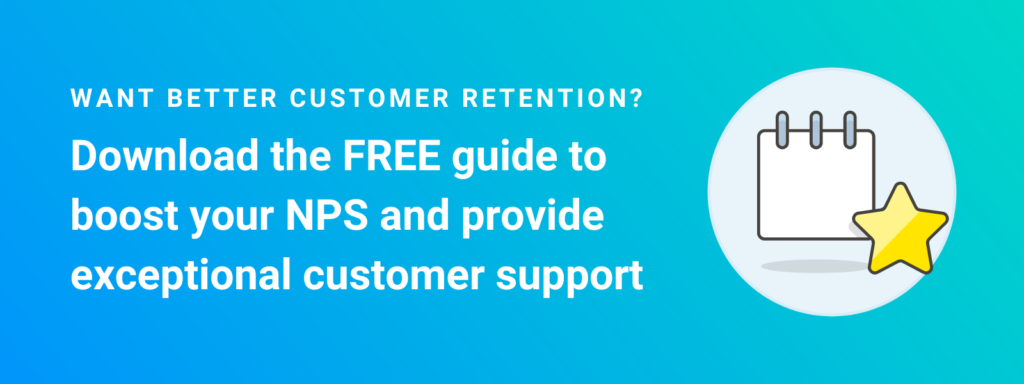According to the Bureau of Labor Statistics, 20% of new businesses fail during the first two year of opening, subsequently, 45% fail in the first five years and 65% in the first ten years. In fact, only a quarter of businesses make it to the 15 year mark.1 Some may consider this to be rather grim, but failure, in fact, can be defined differently for many; however, it almost always precludes a lack of growth. One constant amongst businesses achieving growth well beyond 15 years is their investment in customer retention. This article will explore what customer retention is, why it matters, how to analyze CR and perhaps most importantly, how do businesses improve upon it.
Want to learn more about how to improve your customers' experiences?
What is customer retention?
Customer retention is a metric that businesses use to measure customer loyalty and their ability to keep those customers over time. Customer retention also refers to a company’s ability to engage in the process of maintaining relationships with current customers to delight and excite them long after their purchase. This relationship creates customer success, customer loyalty and turns one-time customers into long-term buyers.
Why is customer retention important?
For many businesses, ROI is a major key performance indicator that’s used as a gauge or determinant of profitability and expenditure. According to Frederick Reichheld of Bain & Company, the inventors of Net Promoter Score (NPS), increasing customer retention rates by 5% increases profitability upwards of 25% to 95%.2 Studies show that it’s more cost-effective to retain customers than to acquire new ones. According to Gartner, 80% of a company's future revenue will come from 20% of its existing customer base.3 It’s clear to see the importance of customer retention to a company’s continued growth. Businesses that focus on improving customer retention are not only prioritizing customer satisfaction, but also increasing return on investment; therefore, boosting brand awareness. Returning customers haven been found to spend significantly more than new customers. Not only do they buy more, but satisfied, loyal customers are also more likely to sing a company’s praises, drive brand awareness via social media and refer their provider to others.
How to improve customer retention
Identify customer hardships
Understanding how to improve customer retention requires businesses to understand the problems that customers are facing in each respective industry. The telecom industry has a customer retention success rate of 78%.4 Anyone who has owned a smart device has, at some point, needed to troubleshoot their device only to realize the lack of self-serve resources available to them to answer their questions. Whether it's on their provider's website or mobile app, when customers aren't able to find the answers that they're looking for, they often result to calling into a support center for more information. Not to mention, when a customer is left having to explain information about a device they may know little about, they're left confused and, unfortunately, oftentimes frustrated from the interaction. When businesses take the time to identify and target customer hardships, they are more likely to work to combat these issues long-term and ultimately prioritize what's most vital: the customer experience.
Build trust with your customers
For many businesses, customer support is considered the heart of the business. When establishing a foundation of trust with your customers, it's critical to be providing top-of-the-line customer service. One way to garner this is with accessible and reliable self-serve support resources through all digital channels. Providing customers with support tools in which they can they are empowered to troubleshoot their issues and learn more about their devices or apps builds confidence and customer loyalty.
When companies lack self-serve support options, this often leads to an influx of calls into the contact center, which costs businesses valuable time, money and resources. Not to mention, when agents have to handle hundreds of support calls a day without reliable answers for customers, this can cause significant stress on teams and ultimately impact how your customers rely on your business for support In order for teams to support customers in an effective manner with confidence and foster trust between customers, contact centers must also have the right tools to support their agent workforce. With Ozmo for Agents, customer support agents have access to the most up-to-date support tools to enable them to support your customers in an effective and efficient manner with confidence.
Gather the right insights
In the rapidly advancing world of technology, it has become increasingly important to stay engaged and informed. Customer retention demands that companies maintain consistency in their engagement with customers in order to learn what tools are working best and how to improve customers' experiences and meet their needs. Asking for customer feedback on self-serve platforms or during customer support calls can drive company awareness and provide insight into industry trends and what customers would want in the future. A company’s CSM (customer success management) team must understand what customer’s most frequently asked questions are, and what answers they’re seeking.
Always keep customers informed, engaged and top of mind
Keeping customers informed, engaged and top of mind is yet another key component to customer retention. Providing customers with details related to upcoming product releases, features and benefits keeps individuals informed about the services and products they invest in thus driving the confidence to make investments in more of your products and services. Remaining engaged with your customer by asking for feedback on how to improve their overall experience evolves from a transaction into a relationship nurtured with reliable and accessible customer support tools. Natasha Ganem of Lion Leadership recommends showcasing clients on digital channels and linking back to them helps to build brand awareness and gives your company a leg up on the competition. This is a prime example of keeping customers top of mind and nurturing those relationships.
Customer retention as we established, is an extremely important part of every company development. It can be a cost-effective approach for a company’s ability to drive growth as opposed to focusing solely on new customer acquisition. Improving retention by identifying customer hardships, building trust between your customers, gathering the right insight and remaining engaged while keeping customers informed and top of mind are all vital in improving a company’s customer retention efforts.




